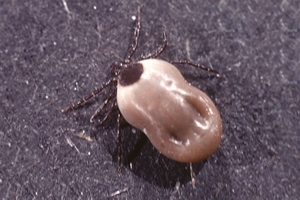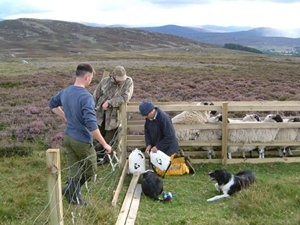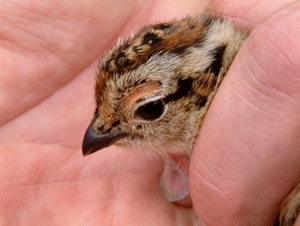Key points
- Ticks feed on the blood of animals, mainly sheep, red deer and red grouse.
- Red grouse chick survival is reduced if lots of ticks feed on them.
- Treating sheep for ticks more frequently reduced the number of ticks feeding on grouse chicks.
- Deer can host many ticks and sites with higher deer density had lower grouse breeding success.
- Sites with more frequent acaricide treatment had lower tick burden on grouse chicks, even for sites with higher deer densities.
- The study suggests hares and grouse benefit from grouse moor management.
- A combination of frequent acaricide treatment for sheep, combined with deer control, would reduce the impact of ticks on red grouse.
Background
 Ticks are blood-sucking parasites that feed on a wide range of host species. They can spread diseases such as Lyme disease (Borrelia) and louping ill virus (LIV) that can have an impact on livestock, wildlife and humans.
Ticks are blood-sucking parasites that feed on a wide range of host species. They can spread diseases such as Lyme disease (Borrelia) and louping ill virus (LIV) that can have an impact on livestock, wildlife and humans.
The most common tick species in the UK is the sheep tick. It has a three-stage lifecycle: larvae, nymph and adult. Every tick life stage can feed on a range of hosts including voles, hares, red grouse, sheep and red deer. However, each life stage increases in size, so needs a larger meal of blood than before. This means most adult ticks feed on larger mammals, notably hares, sheep and deer.
The sheep tick’s abundance and distribution are increasing in the UK because of more rough grass and woodland habitats, a warmer, wetter climate and higher numbers of hosts, especially deer. As well as human health concerns, an increase in sheep ticks could affect red grouse populations, a gamebird of conservation and economic importance. This is because the main period of sheep tick activity overlaps with the chick-rearing period for upland birds. Sheep ticks and the LIV disease they can spread have been shown to affect sheep health and seriously reduce grouse chick survival.
Sheep graze on moorland that are managed for grouse, so tick management in the uplands can be carried out by treating those sheep with an acaricide (a pesticide that kills ticks and mites). Where sheep are the main tick host, regular treatment of a flock can reduce the number of ticks on grouse chicks and the prevalence of LIV, therefore improving chick survival. However, red deer and mountain hare are also tick hosts, and sheep-based tick management could be less effective where numbers of these alternative hosts are higher. This study looked at how sheep management and wild host densities affected the number of ticks, as well as grouse health and breeding success.
What they did
This study compared moorland sites that varied in:
- Frequency of sheep tick treatment
- Sheep, mountain hare and red deer abundance measures
With indicators of grouse population health:
- Tick burdens on grouse chicks
- Grouse breeding success
- The prevalence of LIV in the grouse population
 Information was gathered from 12 sites across northeast Scotland for two years. The sites were all heather moorlands managed for grouse shooting. Adult sheep on all sites were treated with acaricide and the interval between treatments was noted (six to ten-week intervals).
Information was gathered from 12 sites across northeast Scotland for two years. The sites were all heather moorlands managed for grouse shooting. Adult sheep on all sites were treated with acaricide and the interval between treatments was noted (six to ten-week intervals).
Some areas vaccinated their sheep against LIV once per season, some twice, and some did not vaccinate. Blood samples from shot red grouse at ten sites were tested for LIV.
To consider the abundance of large animals on a site, sheep and red deer density were recorded. The size of the sheep flock was known from estate staff, and sheep numbers were counted in summer. Red deer were counted and recorded as high density if more than six per square kilometre were seen, or low density if fewer than six. It is not possible to measure hare abundance accurately, but it can be estimated using the number of hares seen during surveys with pointing dogs. This gives an estimate of mountain hare abundance, which is used as a proxy for hare numbers.
In May and June, grouse chicks aged between five and 25 days old were checked for ticks to determine tick burden. Grouse productivity was monitored between July and August using pointing dogs. Three measures were used to illustrate productivity; average brood size at fledging (chick survival), proportion of hens with broods (nest survival), and the ratio of young to adult birds (overall breeding success).
What they found
Sheep tick treatment
When sheep were treated at six-week intervals, grouse chicks had an average of 1.7 ticks. When sheep were treated at ten-week intervals, grouse chicks had an average of 14.6 ticks.
Effect of tick number
Tick numbers were variable between sites and between years. When tick burdens were higher, chick survival and overall breeding success were lower. However, there was no relationship between tick burden and nest survival.
Measures of sheep, hare and deer abundance
Sheep and deer abundance and the hare estimate were all variable between sites. Sites with higher deer density had higher tick burdens, lower red grouse chick survival, and lower overall grouse breeding success compared to sites with low deer density. Even within sites that had high deer density, lower tick burdens were seen when acaricide treatments were more frequent. Sites with higher hare abundance estimates also had higher chick and nest survival.
Neither sheep density nor hare abundance estimates were found to have an effect on grouse tick burdens in this study.
LIV
LIV disease was found in grouse at five sites, but there was no correlation between sheep vaccination strategy and whether LIV was found in grouse. The level of LIV did not explain any differences in grouse breeding success. This may be because many other factors affect grouse survival and breeding success, and the number of sites was not high enough to detect an effect of LIV.
What does this mean?
 This study suggests that frequently treating moorland sheep for ticks reduces the average number of ticks found on grouse chicks. Sites where sheep were treated at six-week intervals had 88% lower tick burdens on grouse chicks than sites where sheep were treated at ten-week intervals. Chick survival was lower where tick burdens were higher, confirming what has been found in previous studies.
This study suggests that frequently treating moorland sheep for ticks reduces the average number of ticks found on grouse chicks. Sites where sheep were treated at six-week intervals had 88% lower tick burdens on grouse chicks than sites where sheep were treated at ten-week intervals. Chick survival was lower where tick burdens were higher, confirming what has been found in previous studies.
Despite this, a direct relationship was not found between the frequency of acaricide treatment and grouse productivity overall. This is probably because tick burden and tick-borne diseases are only two of many factors that can affect grouse productivity.
Areas with higher grouse productivity also had a higher estimate of hare abundance. This association suggests that the moorland management carried out to manage moors for grouse also benefit hares.
Sites that had lower deer density because of deer culling or fencing, had higher chick survival and breeding success. However, even when deer density was high, more frequent acaricide treatment of sheep still lowered the tick burden on grouse chicks.
From a management perspective, efforts to reduce the impact of ticks on red grouse should focus on a combination of deer control and tick management on sheep.
Read the original abstract
Fletcher, K., & Baines, D. (2018). The effects of acaricide treatment of sheep on red grouse Lagopus lagopus scotica tick burdens and productivity in a multi-host system. Medical and Veterinary Entomology, 32: 235-243.